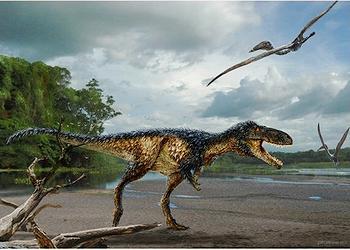
WASHINGTON, DC, March 16, 2016 (ENS) – A newly discovered species of dinosaur, named Timurlengia euotica, lived about 90 million years ago and fills a 20 million-year gap in the fossil record of tyrannosaurs, finds new research by a team of American, Russian and Scottish scientists.
The newly found species resolves a “frustrating 20+ million-year gap in the mid-Cretaceous fossil record, when tyrannosauroids transitioned from small-bodied hunters to gigantic apex predators but from which no diagnostic specimens are known,” the team writes.
They described the creature for the first time in a study published in the current issue of the journal “Proceedings of the National Academy of Sciences.”

The fossilized remains of the new horse-sized dinosaur were found in the Kyzylkum Desert of Uzbekistan by Hans Sues, chair of the Department of Paleobiology at the Smithsonian’s National Museum of Natural History, and Alexander Averianov, a senior scientist at the Russian Academy of Sciences.
Sues and Averianov collected the fossils between 1997 and 2006 while co-leading international expeditions to the Kyzylkum Desert.
“Timurlengia was a nimble pursuit hunter with slender, blade-like teeth suitable for slicing through meat,” said Sues.
The new dinosaur’s skull was much smaller than that of T. rex. However, key features of Timurlengia’s skull reveal that its brain and senses were already highly developed, the team says.
The new species is a tyrannosaur but not the ancestor of the enormous Tyrannosaurus rex, which could weigh more than seven tons, the scientists determined.
Timurlengia was about the size of a horse and could weigh up to 600 pounds. It had long legs and was likely a fast runner.
“It probably preyed on the various large plant-eaters, especially early duck-billed dinosaurs, which shared its world,” said Sues. “Clues from the life of Timurlengia allow us to fill in gaps and better understand the life and evolution of other related dinosaurs.”

Sues and a team of paleontologists led by Steve Brusatte at the University of Edinburgh studied tyrannosaur fossils collected from the international expedition and discovered the new species.
The team later reconstructed the brain of the dinosaur using CT scans of its brain case to glean insights into the new species’ advanced senses.
“The ancestors of T. rex would have looked a whole lot like Timurlengia, a horse-sized hunter with a big brain and keen hearing that would put us to shame,” Brusatte said. “Only after these ancestral tyrannosaurs evolved their clever brains and sharp senses did they grow into the colossal sizes of T. rex. Tyrannosaurs had to get smart before they got big.”
The first tyrannosaurs lived around 170 million years ago and were only slightly larger than a human.
By the late Cretaceous Period – around 100 million years later – tyrannosaurs had evolved into enormous animals like T. rex.
The fact that the new species was still small some 80 million years after tyrannosaurs first appeared indicates that huge size developed only at the very end of the group’s evolutionary history, the team says.
“Tyrannosauroids apparently developed huge size rapidly during the latest Cretaceous, and their success in the top predator role may have been enabled by their brain and keen senses that first evolved at smaller body size,” the team explains in their study.
The study also shows that before the evolution of their massive size, tyrannosaurs had developed keen senses and cognitive abilities, including the ability to hear low-frequency sounds.
This positioned them to take advantage of opportunities to reach the top of their food chain in the Late Cretaceous Period after other groups of large meat-eating dinosaurs had gone extinct.
“Central Asia was the place where many of the familiar groups of Cretaceous dinosaurs had their roots,” Sues said. “The discoveries from the Kyzylkum Desert of Uzbekistan are now helping us to trace the early history of these animals, many of which later flourished in our own backyard in North America.”
The new study was funded by the European Commission. The fieldwork was supported by the National Science Foundation and the National Geographic Society. The work was carried out in collaboration with researchers at the University of Edinburgh, Russian Academy of Sciences and Saint Petersburg State University.
